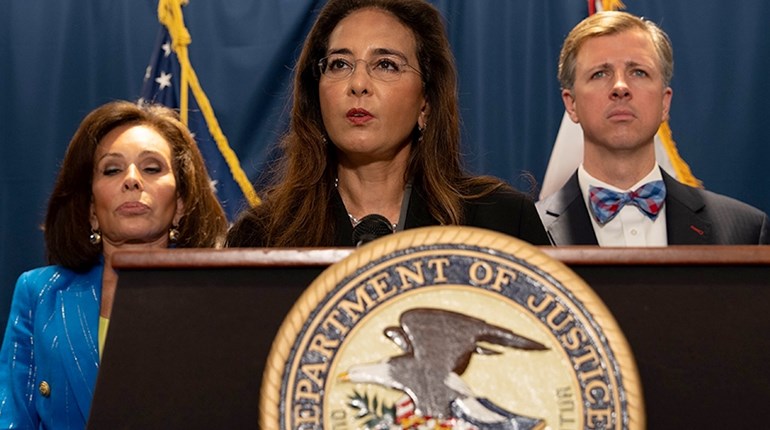
While President Donald Trump’s (R) victory is welcome news, it is clear that threats to our rights will not be going away. In September, gun owners received a stark reminder of this problem when Joe Biden (D) and Kamala Harris (D) announced new executive orders targeting gun owners.
At the ceremony where Biden and Harris announced these measures, the vice president claimed “the right to be safe is a civil right,” as is the “right … to live … without fear of violence, including gun violence.” This statement underscores the false promise of gun control: superficially appealing; useless in practice; and contrary to American law and history, in which rights function mainly to restrain illegitimate government action rather than to “guarantee” outcomes the government cannot deliver.
Fortunately, the orders themselves were, in this case, long on election-year rhetoric and short on substance. One created an interagency task force to study and report on strategies to “stop the proliferation of machinegun conversion devices,” and another required a report to “address the emerging threat related to 3D-printed firearms.”
A White House press release accompanying the orders made it clear that the government will be tasked with creating a taxpayer-funded report to be used to push lawmakers to increase the power and resources of the federal bureaucracy, noting, “The report will include any additional authorities or funding the federal agencies need from Congress in order to complete this work.”
Given the Biden-Harris administration’s anti-gun record, Americans have every reason to believe that the order will be used to attack Second Amendment rights. However, certain aspects of the order suggest the administration is also seeking to undermine the First Amendment right to freedom of speech.
Since before the Founding, Americans have enjoyed the right to make their own firearms without government interference. Barring state law to the contrary, this practice remains lawful today. The method of manufacture, whether it be a home workshop with a drill press or a home office with a 3D printer, does not change the underlying federal law.
Biden’s executive order targets modern manufacturing processes in ways that create serious implications for Americans’ First Amendment rights.
The order stated that the “task force” report shall include:
(iii) an assessment of existing authorities, including export and import laws, that regulate software or technology used for 3D printing firearms, including undetectable firearms;
(iv) an assessment of the technological feasibility of 3D printers proactively blocking the functional capacities of software used to 3D print undetectable firearms;
…
(vi) an interagency plan for effective coordination between the Department of Justice and the Department of Commerce to limit the illegal export or import of software or technology on the internet that can be readily used to illegally 3D print firearms, including unserialized or undetectable firearms.
Note the order emphasized assessing plans to restrict software and its capabilities to target 3D-printed firearms. Any restriction on Americans’ ability to create and share this information potentially violates the First Amendment. (Under current law, software or computer code is generally treated as speech.)
In 1999, the U.S. Court of Appeals for the Ninth Circuit addressed this matter in the case Bernstein v. U.S. Department of Justice. The case concerned encryption software, which the government said could not be posted on the internet because such software was categorized as a munition, subject to severe export control regulations.
The court held that the encryption software at issue was protected speech. Further, the court held that as speech, the software was “entitled to the protections of the prior restraint doctrine.” The prior-restraint doctrine makes clear that the government cannot preemptively restrict the publication of speech in almost all circumstances.
To give a classic example of a prior restraint, in 17th century Britain, printing presses were licensed. An item summarizing the British regime explained,
The ordinance prohibited the printing, binding, or sale of books except by persons licensed under authority of Parliament and made the Stationers the agent of Parliament for the purpose of licensing printers. Anonymous publications were banned, as were the reprinting or importation of previously printed works. The ordinance authorized the Stationers to conduct searches and seizures of unlicensed publications, destroy unlicensed printing machinery, and to arrest those suspected of printing without a license.
The First Amendment rejects this type of regime and imposes the utmost skepticism on any other type of prior restraint on speech. As the U.S. Supreme Court explained in Bantam Books, Inc. v. Sullivan (1963), “Any system of prior restraints of expression comes to this Court bearing a heavy presumption against its constitutional validity.”
At present, Biden’s executive order only requires his government “task force” to assess options to curtail software capable of assisting in the creation of 3D-printed firearms. As the “task force” includes the attorney general, one could naively hope that the group would be apprised of First Amendment jurisprudence. However, given this administration’s relentless attacks on the Second Amendment, and its willingness to undermine the First Amendment in pursuit of its goals, gun owners and other Bill of Rights supporters should view Biden’s executive order with the utmost suspicion.
At the same ceremony where it announced the executive orders, the Biden-Harris administration celebrated the one-year anniversary of the White House Office of Gun Violence Prevention, which happens to be led by none other than Kamala Harris. As NRA-ILA explained when the office was launched, this effort funnels taxpayer funds to career firearm-prohibition activists. Their job is to create an anti-gun culture within all branches of the federal bureaucracy and to dream up more ways to suppress Second Amendment rights. The administration’s celebration included a “Year One Progress Report” detailing the office’s efforts over the past twelve months.
One of the more substantive functions of the office has been to require accountability of other components of the bureaucracy for implementation of the misnamed Bipartisan Safer Communities Act (BSCA), a sprawling package of anti-gun legislation that Joe Biden signed into law in 2022. Its main provisions focused on longstanding and generic items of the anti-gun agenda, including expanding groups categorically prohibited from possessing guns, promoting state firearm seizure laws and giving the government ever more leverage over the lawful firearms industry.
Among the administration’s most radical steps to implement the BSCA was a far-reaching administrative rule released in April to ban various categories of personal firearm transfers between law-abiding people for lawful purposes. Even some of the BSCA’s main supporters countered that such a rule was well beyond anything contemplated by the act. The rule itself has been mired in legal challenges, including one by the NRA, but it remains a monument to how broadly and aggressively an anti-gun administration will interpret and leverage any authority to persecute America’s gun culture.
Another project of Harris’ anti-gun office has been promoting “red-flag” firearm-seizure laws within the states, both by highlighting provisions within the BSCA that can fund such efforts and by creating a “clearinghouse” within the Department of Justice to encourage states’ use of the policy. These laws continue to deprive Americans of their Second Amendment rights with little or no due process, and Harris’ office continues to push more and more states to adopt them.
The office also noted “progress” in leveraging the vast scope and reach of the U.S. government to spread anti-gun messages throughout the bureaucracy and to amplify these themes with various “state and local partners.” Chief among these is the administration’s emphasis on what it calls “safe firearm storage.” This seemingly harmless catchphrase is actually rooted in a culture that considers the presence of a lawfully possessed firearm within a home as a per se danger to occupants and visitors of the residence. The safest course of action, under this way of thinking, is simply to forgo firearm ownership entirely. Short of that, however, gun owners are encouraged to always keep their firearms in an unusable state. According to them, only when the gun is actually being used should it be operable or loaded.
Of course, Kamala Harris herself sees a more-nefarious role for “safe firearm storage.” Recently resurfaced video shows her opining that a “safe-storage” mandate enacted by San Francisco in 2007 empowered city officials to violate the “sanctity” of a “locked home” to ensure lawful gun owners were in compliance with the city’s firearm-storage requirements. This interpretation, however, violates clearly established Fourth Amendment protections, to say nothing of the Second Amendment.
Despite Harris’ rhetoric at the ceremony announcing the orders about the right to be and feel safe, the orders included a disclaimer that they were “not intended to, and [do] not, create any right or benefit, substantive or procedural, enforceable at law or in equity by any party against the United States, its departments, agencies, or entities, its officers, employees, or agents, or any other person.” In other words, if the government ignores its own orders, it can’t be held to them.
That, perhaps, is the best summation of gun control in general. Gun control promises much but doesn’t deliver. And if it should disappoint you, take heart. There’s always more gun control where that came from. That’s why we need to continue to stand together to defend our fundamental rights. Those who seek to implement the false promises of gun control aren’t giving up, and neither can we.


































